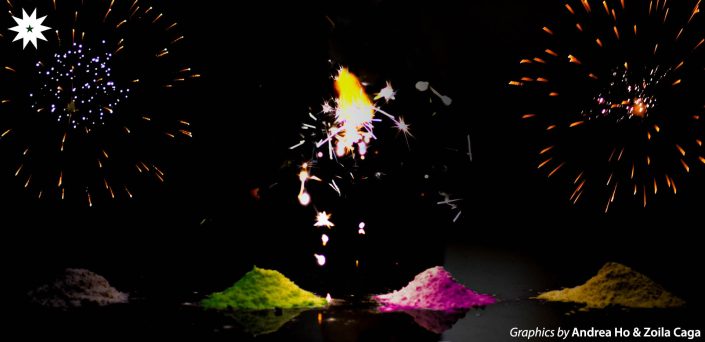Picture a flower unfolding with a rumble against the night sky. Glittering greens, brilliant blues, and riveting reds—nothing screams “celebration” like fireworks. Worldwide, these spectacular explosions are a regular feature of national holidays, religious festivals, and the start of a new year. Powering these displays is a medley of chemicals that have been used and studied for centuries.

Spark of science
According to Gabriel Caruntu, a chemistry professor at Central Michigan University, the earliest records of fireworks depicted Chinese alchemists throwing bamboo stalks into a fire to create sounds. As the air inside the bamboo heats up, it crackles apart. Years later, they filled it with gunpowder, which they developed after combining saltpeter—or potassium nitrate—with sulfur and charcoal. When exposed to heat, the mixture would explode with a loud bang. While it was previously used to create noise to ward off malicious spirits, it is used today to propel fireworks into the sky.
Apart from gunpowder, there are three other key ingredients of a firework: oxidizers, fuels, and binders. Oxidizers are oxygen-rich chemicals like nitrates and chlorates, while fuels are metals like aluminum and magnesium. Together, they generate a redox reaction—a process that involves the transfer of negatively charged particles called electrons. The binder serves as the glue that holds these chemicals together, allowing the firework to explode at a specific time. The most common binder is dextrin, a type of starch.
Ludwig-Maximilians University researcher Dr. Magdalena Rusan notes that the ratio between these ingredients is essential. One may assume that combining equal amounts of oxidizer and fuel is best, but this is not the case. “What you need to [do] is try [a] composition and [see] if it’s good,” she explains, stating the need to generate high amounts of energy in the reaction. Beyond this, “altering the composition of a firework will [also] lead to significant changes in the effects they produce,” echoes Caruntu.
He illustrates that metallic compounds, including salts, differ in the distribution of their electrons. Upon the ignition of fireworks, these electrons enter their excited states, fall back to their normal levels, and subsequently release energy in rapid succession. “This energy which is emitted is of a certain wavelength, and we observe [such] as the colors that we see,” Rusan describes. Therefore, metals are intrinsically associated with prompting their own distinct colors: strontium salts for red, barium for green, and copper for blue.
Beyond their vibrant blends, these fuels and salts may be physically packaged in a way that draws pictures or a preferred series displayed in the sky. Caruntu details that such designs are majorly attributed to rocket design instead of chemistry. “Circular patterns are the result of fuel[s] packed in a cardboard tube [that is] surrounded by small pellets of metals forming a ring.”
To produce crackling sounds, the chemistry professor posits that a mixture of bismuth trioxide and aluminum and magnesium alloys is added into the mix. For a spectacular finale, there is the option to connect sections of fireworks in a linear series—a grant of explosions one after the other.
Dazzling pollutants
Despite the dazzling display, the lingering smoke emitted by fireworks is laced with risks to both health and the environment. Francis Pope, an atmospheric science professor at the University of Birmingham, says that the smoke of fireworks stays in the air for 12 to 24 hours, depending on weather conditions. Caruntu adds that the smoke emits greenhouse gases such as carbon dioxide and ozone, which damages the ozone layer and contributes to climate change.
Fireworks smoke also contains particulate matter (PM), which are hazardous particles suspended in the air. Genevieve Lorenzo, a graduate student at the University of Arizona who did research on the topic, explains that high PM concentrations from fireworks degrade air quality, specifically fine particulate matter (PM2.5). A report from the Manila Observatory showed that, in different cities in the Philippines, PM2.5 concentrations exceeded the United States Environmental Protection Air Quality Index during New Year’s Eve in 2021. This puts the population at risk of eye allergies, cough, fever, and other adverse effects on the respiratory and cardiovascular systems.
Lorenzo furthers that PM from fireworks decreases the visibility of the night sky as they scatter in the air. The discharge of the harmful particles also affects the hydrosphere, as toxic-induced rain deposits into bodies of water, degrading surface ecosystems.
The loud bangs, high-pitched whistles, and crackling sounds of fireworks displays also contribute to noise pollution. These may cause stress to humans and animals, making them susceptible to hearing loss and tinnitus—or ringing in the ears. With this, Rusan suggests manufacturing fireworks that do not produce loud sounds to mitigate such health hazards.
Friendly features
From ancient rituals to modern-day celebrations, fireworks remain the anticipated feature of an event. However, Rusan underscores the importance of conducting research and risk assessments to replace these components with less harmful chemicals or, better yet, more environmentally friendly compounds. Pope also suggests using alternative displays during a celebration, such as drones, to help reduce the environmental and health impacts of fireworks. These bright displays in the night also serve as a warning to everyone—to be more aware of how dangerous displays are masked as friendly features.
